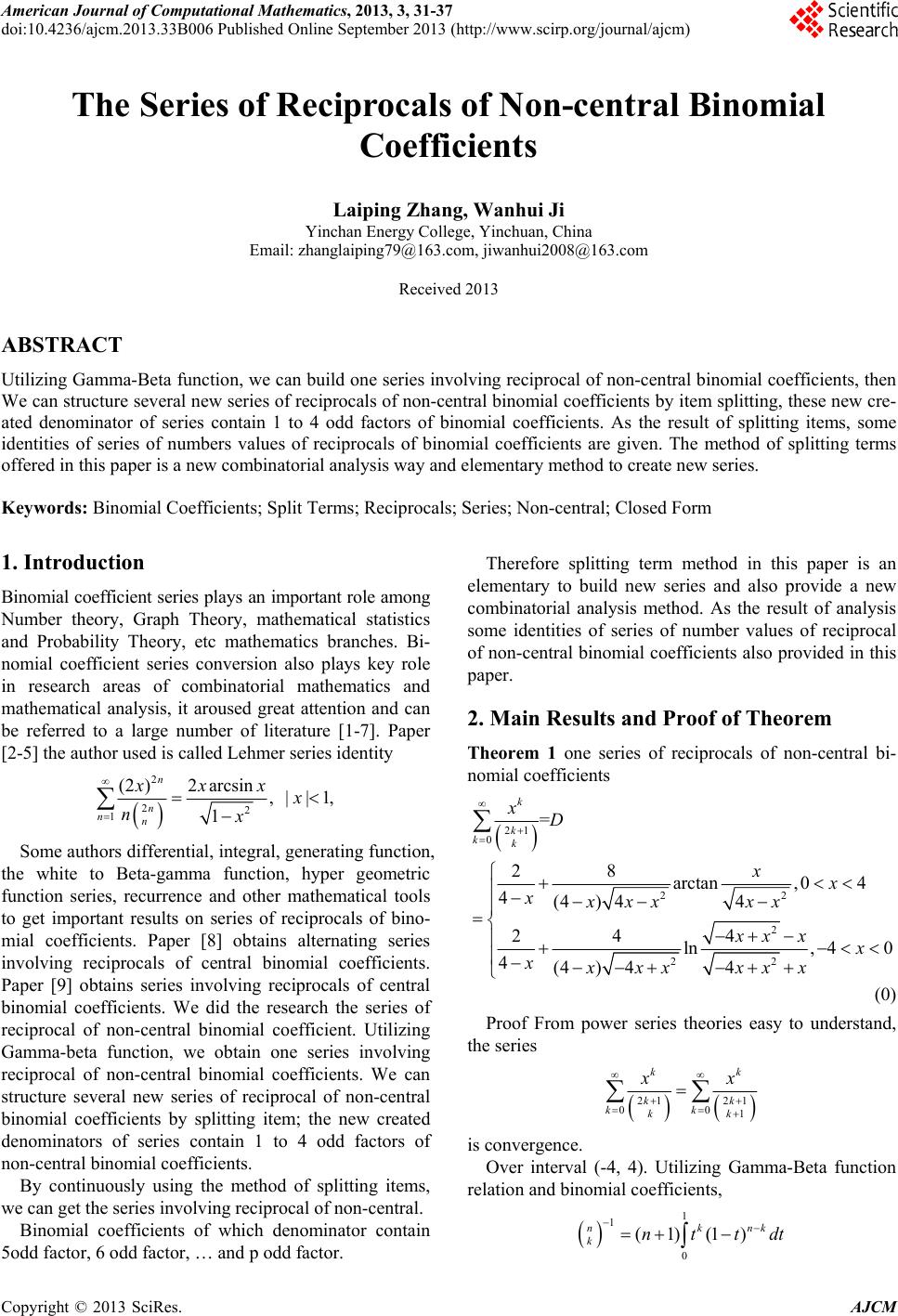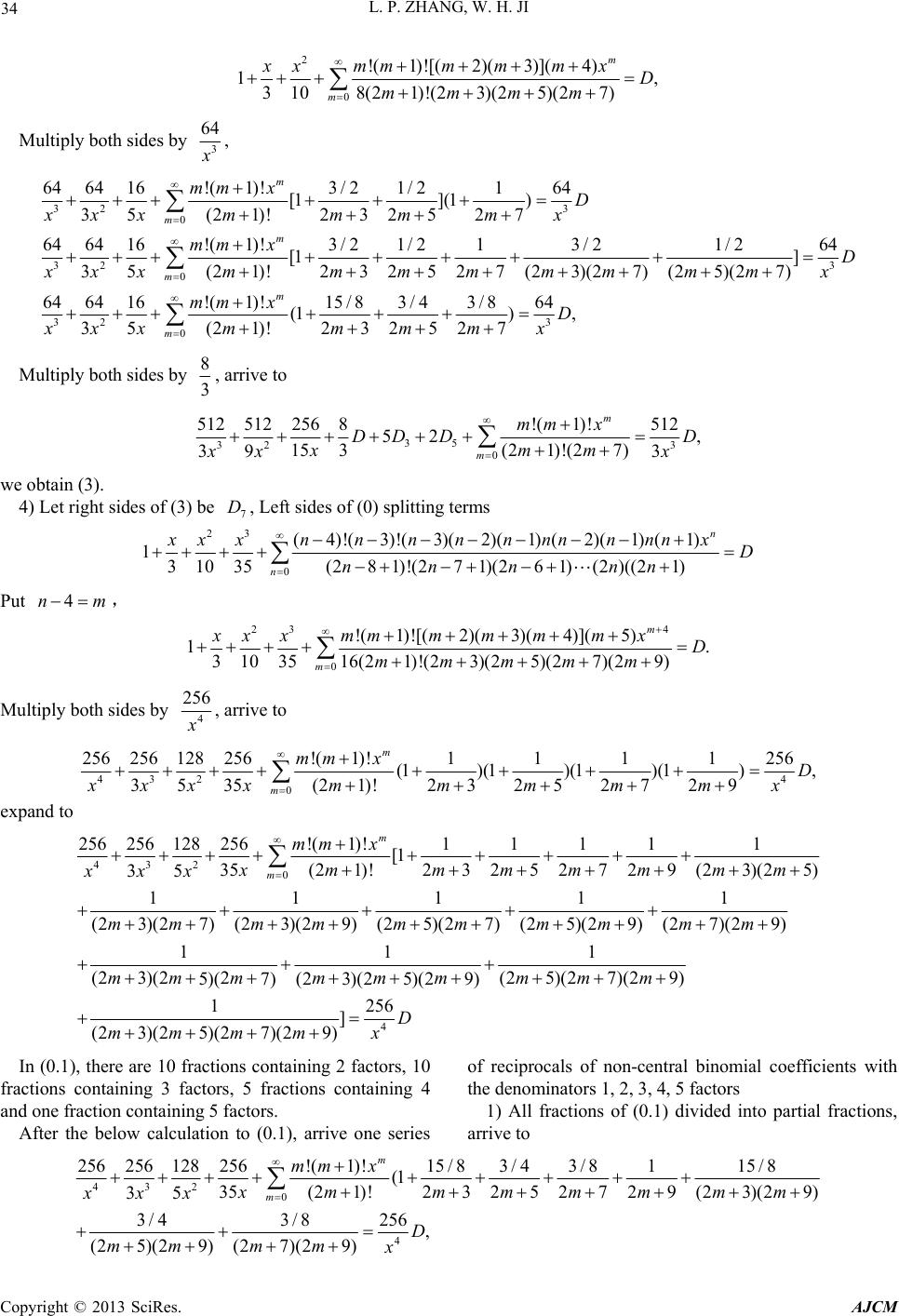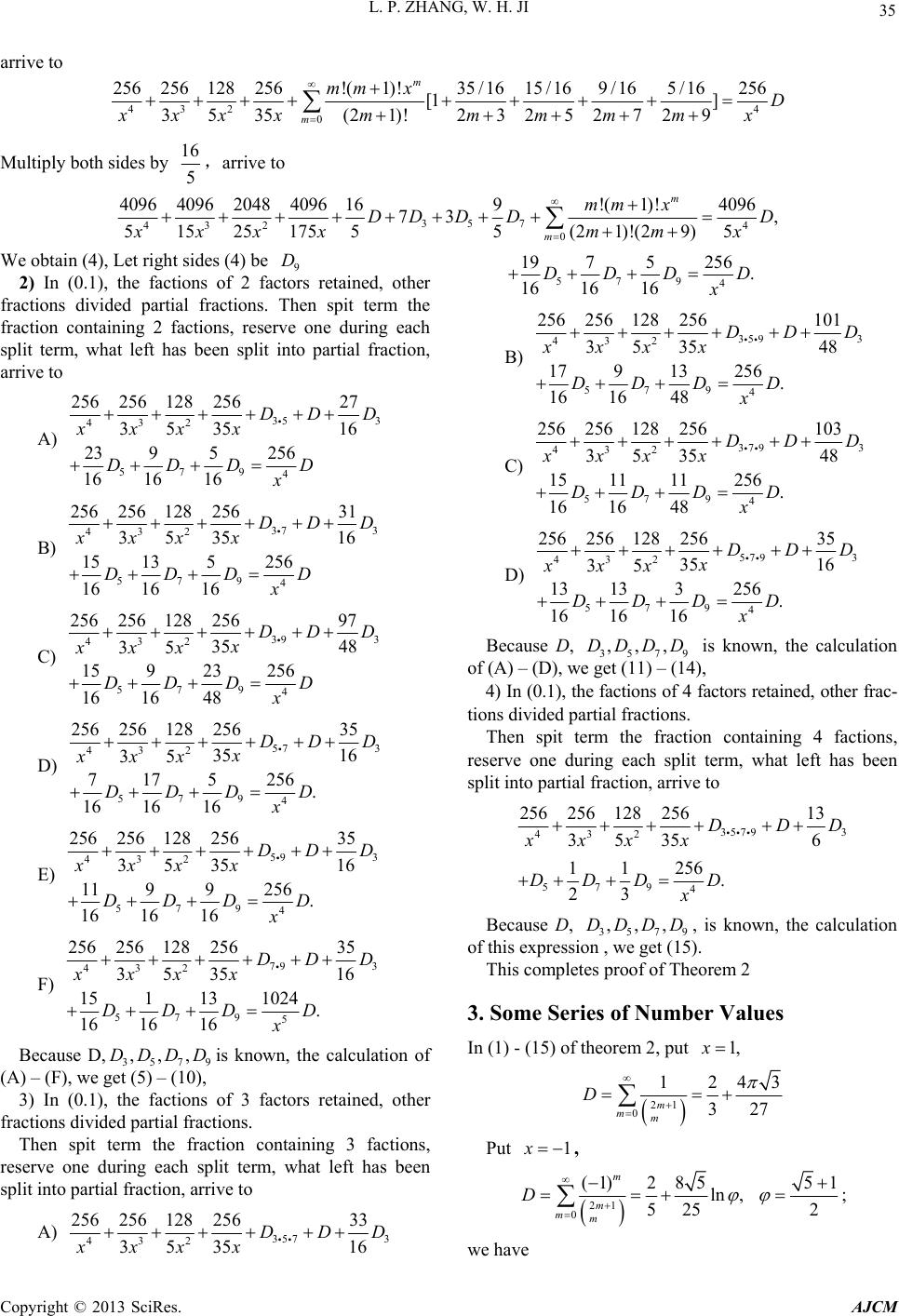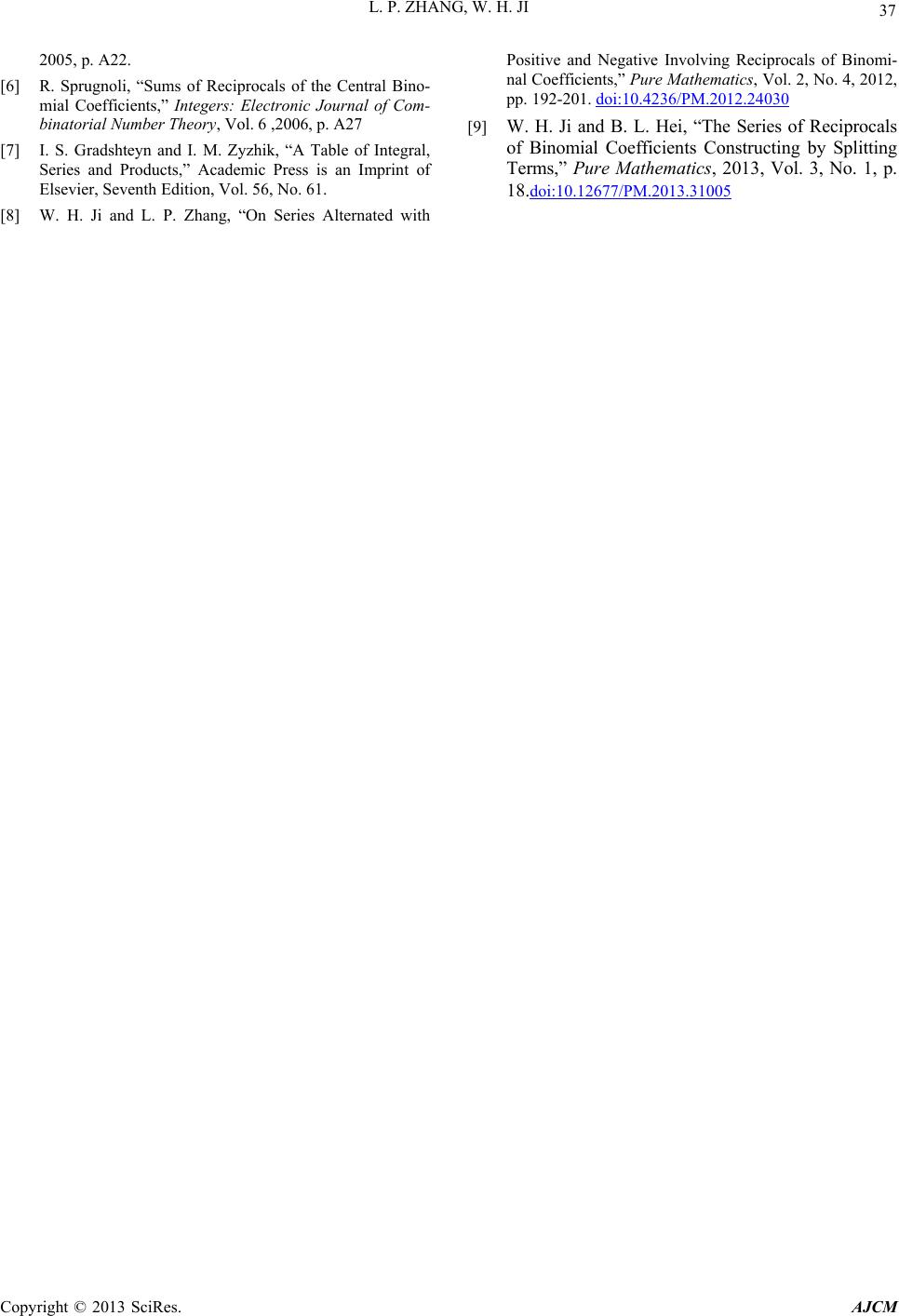Paper Menu >>
Journal Menu >>
 American Journal of Computational Mathematics, 2013, 3, 31-37 doi:10.4236/ajcm.2013.33B006 Published Online September 2013 (http://www.scirp.org/journal/ajcm) The Series of Reciprocals of Non-central Binomial Coefficients Laiping Zhang, Wanhui Ji Yinchan Energy College, Yinchuan, China Email: zhanglaiping79@163.com, jiwanhui2008@163.com Received 2013 ABSTRACT Utilizing Gamma-Beta function, we can build one series involving reciprocal o f non-central binomial coefficien ts, then We can structure several new series of reciprocals of non-central binomial coefficients by item splitting , these new cre- ated denominator of series contain 1 to 4 odd factors of binomial coefficients. As the result of splitting items, some identities of series of numbers values of reciprocals of binomial coefficients are given. The method of splitting terms offered in this paper is a new combinatorial analysis way and elementary method to create new series. Keywords: Binomial Coefficients; Split Terms; Reciprocals; Series; Non-central; Closed Form 1. Introduction Binomial coefficient series plays an important role among Number theory, Graph Theory, mathematical statistics and Probability Theory, etc mathematics branches. Bi- nomial coefficient series conversion also plays key role in research areas of combinatorial mathematics and mathematical analysis, it aroused great attention and can be referred to a large number of literature [1-7]. Paper [2-5] the author used is called Lehmer series identity 2 22 1 (2 )2arcsin, ||1, 1 n n nn xxx x nx Some authors differential, integral, generating function, the white to Beta-gamma function, hyper geometric function series, recurrence and other mathematical tools to get important results on series of reciprocals of bino- mial coefficients. Paper [8] obtains alternating series involving reciprocals of central binomial coefficients. Paper [9] obtains series involving reciprocals of central binomial coefficients. We did the research the series of reciprocal of non-central binomial coefficient. Utilizing Gamma-beta function, we obtain one series involving reciprocal of non-central binomial coefficients. We can structure several new series of reciprocal of non-central binomial coefficients by splitting item; the new created denominators of series contain 1 to 4 odd factors of non-central binomial coefficients. By continuously using the method of splitting items, we can get the series involving reciprocal of non-central. Binomial coefficients of which denominator contain 5odd factor, 6 odd factor, … and p odd factor. Therefore splitting term method in this paper is an elementary to build new series and also provide a new combinatorial analysis method. As the result of analysis some identities of series of number values of reciprocal of non-central binomial coefficients also provided in this paper. 2. Main Results and Proof of Theorem Theorem 1 one series of reciprocals of non-central bi- nomial coefficients 21 0 22 2 22 = 28 arctan,0 4 4(4) 44 24 4 ln, 40 4(4) 44 k k kk xD xx xxxx xx xx xx xxxx xxx (0) Proof From power series theories easy to understand, the series 21 21 00 1 kk kk kk kk x x is convergence. Over interval (-4, 4). Utilizing Gamma-Beta function relation and binomial coefficients, 1 1 0 (1)(1) nk knttd nk t Copyright © 2013 SciRes. AJCM  L. P. ZHANG, W. H. JI 32 we calculation sum function of series 11 21 000 k kk k 11 11 00 00 11 00 00 11 2 00 (22)(1) =2(1 )+2(1 ) =2(1 )+2(1)' (1 ) 22 1(1) [1(1 )] 1(1)1 2[1 (1 kkkk kk kkk k kk kk kk xxk ttdt kx ttdtx ttdt kxtttdt xtttdt xt ttdt dt xt t xt t xt t xt 11 2 00 1 22 0 21(1) )] 2[1 ] tdt tdt xt t t tdt xt xt Using recursion formulas of integral [7] 1 2 0 44 1 xx xt xt 1 2 0 22 11 1 2 22 1 44 1 28 arctan , 4(4) 44 dt dt xx xt xt x x x xx xx for 04x 2 22 24 4 ln , 4(4) 44 x xx x x xxxx x for . This completes proof of Theorem 1 Theorem 2 The series of reciprocals of non-central binomial coefficients The denoial co 40x . 1)minator contains 1 odd factor of binom efficients in the series 21 0 44 =( 1) (2 3) m mm xD m x x m (1) 22 21 0 32 12324 D=(1) 3 (2 5) m m mm x x x xx m (2) 32 21 0 32 512 644 1 () 3 3 (2 7) 512 644 15 39 m m mm x x xx m D x xx (3) 432 21 0 432 4096 15369641 () 55 555 (2 9) 4096 512324 35 51525 m m mm x x xxx m D x xxx (4) 2) The denominator contains 2 odd factors of binomial coefficients in the series 21 0 22 16 816 8 (1)D (23)(2 5) 3 m m mm x mm x x xx (5) 21 0 323 2 (23)(2 7) 128 1611281616 () 31 339 m m mm x mm D5 x xxx x (6) 21 0 323 2 2564881256 1768 () 31 3 (25)(2 7 39 ) m m mm D5 x x xx x m x m x (7) 21 0 432 432 2048 2561681 () 15 5 155 5 2048 256162 (23)(2 9 4 35 15 45 ) 75 m m mm D x xx x mm x x xxx (8) 432 4 1 2 2 0 3 1024 3841616 1 () 55 555 1024 12820832 105 5 (25)(2 9) 15 25 m m mm x D x xxx x xxx mm (9) 432 4 1 3 2 2 0 2048 3584 20881 () 515 5155 2048 5126568 1 (27)(2 9) 05 55225 m m mm D x xxx x xx x x mm (10) 3) The denominator contains 3 odd factors of binomial coefficients in the series 21 0 323 2 64164164804 ( ) 3 3 D (23)(2 5)(27 5 39 ) m m mm x m x x x mm x (11) xx 43 21 0 2 432 512641628 1 () 15 5 15 5 5 512 64304 12 1 (2 3 05 1545 7 )( 2 5 5)(2 9) m m mm x mmm D x xxx x xxx (12) Copyright © 2013 SciRes. AJCM  L. P. ZHANG, W. H. JI Copyright © 2013 SciRes. AJCM 33 21 0 432 43 2 1024 7044841 () 15 15 15 155 1024 10881 (23)(2 7)(2 76 4 21 15 45 9) 225 m m mm D x x mmm xxx x xx x (13) 432 4 1 3 2 2 0 512 1216 112121 () 515 515 (25)(2 7 5 51270 )(2 9 4 12284 35 5 ) 15 225 m m mm D x x mm x m xxx x xx (14) 4) The denominator contains 4 odd factors of binomial coefficients in the series 432 () 15 15 15 155 256 512 D x xxx (15) 1 42 2 3 0 256 256 32161 544 16 105 1 (2 3)(2 5)(2 7)(2 9) 545225 m m mm x mm x xx m x m Proof of Theorem 1) Left sides of (0) splitting terms 0 !( 1)! (2 1)! n n nnx D n 0n 0 (1 )!!() !( 1) (1) 1, (221)!(211)(1 ! ) n n n nnnnx n nn D n x put (2 1)!n 2n 1nm , 1 0 !( 1)!( 1)(2) 1, (2 1)!(22)(23) m m mmmm xD mmm Multiply both sides by 4 x , arrive to 0 0(2 1)2 3 m 4!(1)!(231)4 , (2 1)!(23) 4!(1)! 14 (1) , ! m m m mmmxD xmmx mm xD x mm x We obtain (1). Let right sides (1) be.(2). Left sides of (0) splitting terms 0(2 4 1)!(231)(221)(21)((21) nnn nnn 13 (2)!( 1)!( 1)(1) 1 , n x nnnnnnx D put 2nm 2 0 13 !( 1)!( 1)(2)(2)(3) (21)!(22)(23)(24)(25) , m m x mmmmmm x mmmmm D 2 16 x , arrive to Multiply both sides by 20 2 20 2 20 2 16 16!(1)! 3(21)! 1116 (1 )(1) 23 25 16 16!(1)! 3(21)! 111 16 (1 )= 2325(23)(25) 16 16!(1)! 3(21)! 3/2 1/216 (1 ) 2325 m m m m m m mm x xm x D mm x mm x xm x D mm mmx mm x xm x D mmx Multiply both sides b, arrive to y2 3 2 2 0 3232 23 3 !( 1)!32 (2 1)!(25) m m DD x x mm xD mm x We obtain (2). Let ri ght sides ( 2) be . 3) Left sides of (0) splitting terms 5 D 2 0 1310 (3)!( 2)!( 2)(1)(1)(1) (26 1)!(251)(24 1)(2) , 1 n n xx nnnnnnnnx nnn n D 3nm put 3 D 2 3 0 !(1)!(1)( 2)( 3)(2)(3)( 4) 1, 310(21)!(2 2)(23)(2 4)(2 5)(26)(2 7) m m xxmmmmmmmmxD mmmmmmm  L. P. ZHANG, W. H. JI 34 2 0 !(1) m mmxD 1, 3108(2 1)!(23)(25)(27) m xxmm m mmmm Multiply both sides by 3 64 x , 32 3 ) 7 D m x 0 32 3 0 32 646416!(1)!3/ 21/ 2164 [1 ](1 5(21)!23252 3 646416!(1)!3/ 21/ 2164 [1 ] 5(21)!2 32 52 7(2 3)(2 7)(2 5)(2 7) 3 6464 16!(1)! 5( 3 m m m m m mm x xm mm xx mm xD xm mmmmmmm xx x mm x x xx 3/ 21/ 2 3 0 15/8 3/43/864 (1) , 21)! 232527 m D mm m x Multiply both sides by m 8 3, arrive to 35 32 3 0 512 512 25 6 8!(1)!512 52 15 3(2 1)!(27) 39 3, m m mm x DD D xmm xD xx we obtain (3). 4) Let right sides of (3) be , Left sides of (0) splitting terms 7 D 23 0 ( 4)!(3)!(3)( 2)(1)( 2)(1)(1) 131035(2 81)!(2 71)(2 61)(2)((21) n n xx xnnnnn nnn nn xD nnn nn Put , 4nm 23 4 0 !(1) 1. 3103516(21)!(23)(2 5)(2 7)(2 9) m m xx xmmmmmmxD mmmmm 4 256 x , arrive to Multiply both sides by 432 4 0 256256128256!(1)!1111256 (1 )(1)(1)(1), 35(21)!2 32 52 729 35 m m mm xD xm mmmm xxx x expand to 432 0 256256128256!(1)!11111 [1 35(21)! 23252729(23)(25 35 11111 (2 3)(2 7)(2 3)(2 9)(2 5)( 11 ) 5)(7) (23)(25)( 27)(25)(29) 7)(29) 29) m m mm x xm mmmmm m m xxx mmmm mm m mmm m m (2 3)(2 2mmm (2 4 1 (2 5)(2 7)(29) 1] (2 3)(2 5)(27)(2 9) 256 mmm D mmmmx In (0.1), there are 10 fractions containing 2 factors, 10 fractions containing 3 factors, 5 fractions containing 4 and one fraction containing 5 factors. After the below calculation to (0.1), arrive one series of reciprocals of non-central binomial coefficients with the denominators 1, 2, 3, 4, 5 factors 1) All fractions of (0.1) divided into partial fractions, arrive to 432 0 3/ 43/ m 4 256256128256!(1)!15/83/ 43/8115/8 (1 35(21)! 23252729(23)(29) 35 8256 , (2 5)(2 9)(2 7)(29) m mm x xm mmmmmm xxx D mmmm x Copyright © 2013 SciRes. AJCM  L. P. ZHANG, W. H. JI 35 arrive to 432 4 0 256256128256!(1)!35 /1615/169 /165 /16256 [1 ] 35(21)!2 32 52 72 9 35 m m mm xD xm mmmm xxx x Multiply both sides by 16 ,ve to 5arri 35 74432 0 4096 40962048 4096 175 169!( 1)!4096 73 555(21)!(29) 515 25 m m mmx DD DD mm x D x xxx , (4), Let right sides (4) be 2) In (0.1), the factions of 2 factos retained, other fractions divided partial fractions. Then spit term the fraction containing 2 factions, reserve one during each s beo partial fraction, arrive to We obtain9 D r split term, what left haen split int A) 3 43 53 579 4 2 27 16 23 95256 16 16 16 256256128256 35 35 DD D Dx x xx DD D x B) 37 432 3 57 4 9 256256128256 35 35 25 31 16 15 135 16 16 6 16 DD D DD x xxx DDx C) 39 432 3 57 4 9 256256 128256 35 35 25 97 48 15 92 611648x 63 DD D D x xx DDD x D) 57 432 256256 128256 35 35 35 DD D x xxx 3 579 4 16 16 1 166x E) 25671 75 .DDD D 59 4323 579 4 256256 128256 35 35 256 35 16 11 99 16 16 16. x xx DDD DDD x D x F) 79 3 579 5 15 1 1024 16 16 16 DDD x 432 35 16 13 . 256256 128256 35 3 5DD D x xx D x Because D,Dis known, the calculation of (A) – (F) , we gr, other 3579 ,,,DDD et (5) – (1 0 ), 3) In (0.1), the factions of 3 factos retained fractions divided partial fractions. Then spit term the fraction containing 3 factions, reserve one during each split term, what left has been split into partial fraction, arrive to A) 357 3 432 256256 128256 35 36 5 33 1x xxx DD 57 4 9 19 75 16 16 256 16 .DD x DD B) 359 3 5 4 79 32 4 256256 128256 35 35 25 101 48 17913 16 6. 16 48 x xxx D x DD DDD D C) 379 3 5 43 79 2 4 1256 203 48 15 1111 1 56 128256 35 35 2 61648 56 . DD DDD x xxx D x D D) 5 432 3 79 4 79 5 256256 128256 35 35 256 35 16 13 133 16 1. 616 DD DD x xxx DD x D Because D, is known, the calculation of (A) – (D), w, 4) In (0.1), the factions of 4 factors retained, other frac- taining 4 factions, partial fraction, arrive to 3579 ,,,DDDD e get (11) – (14) tions divided partial fractions. Then spit term the fraction con reserve one during each split term, what left has been split into 3579 43 74 3 59 2 256256 1282513 6 11 2 6 35 35 256 3. x xDD DD xx x DD D Because D, , is known, the calculation of this expressi. This completes proof of Theorem 2 3. Some Series of Number Values In (1) - (15) of theorem 2, put 3579 ,,,DDDD on , we get (15) 1,x 21 0 24 3 32 1 7 m mm D D Put x1 , 21 0 285 ln , 525 (1) m m mm D 51 2 ; we have Copyright © 2013 SciRes. AJCM  L. P. ZHANG, W. H. JI 36 Corolla ry 1 The series of number values of reciprocal of non-central binomial coefficients 1) 21 0 1 (2 9 2 43 3) m mmm ; 2) 21 0 1 (2 5 28 3 9 ) 50; 3 m mmm 3) 21 0 1148341058; (2 7945 ) m mmm 4) 21 0 23483 225158 952 1 (2 9) m mmm 5 ; 5) 21 0 1 (2 3)(25) 4322 33 m mmmm ; 6) 21 0 1 (2 3)(2 7) 1078 4345 m mmmm ; 7) 21 0 203 1634; 345 1 (2 5)(2 7) m mmmm 8) 21 09) 15 1575 mm 1 (2 3)(2 1963112054; mmm 9) 21 0(2 5)(29; 15 17 )5 m mmmm 1 284318084 10) 21 0 1 (2 7)(29) 1563 267422 m mmmm ; 51575 11) 21 0 43326; 34 1 5 (2 3)(2 5)(2 7) m mmmmm 12) 21 0 1 (2 3)(2 5)(2 9) 44345316; 15 1575 m mmmmm 13) 21 0 1 (2 3)(2 7)(2 9) 683 38842; 15 1575 m mmmmm 14) 21 0 1 (2 5)(29)(2 9) 92352306; 15 1575 m mmmmm 15) 21 1 (2 3)(2 mmm 05)(2 7)( 43 762; 51 2 75 9) mmmm Corolla ry 2 Alternating series of number values of re- ciprocals of non-central binominal coefficients 1) 21 0 (1) ( 85 ln 2; 5 23) m m mmm 2) 21 (5 46 ln ; 5 m 0(25) mmm 1) 72 3 m 3) 21 0ln 15 (2 7) m mmm (1144 53698; 45 1)m 4) 21 0 183(1) m 2 5206938 ln ; 5525 (2 9) m mmm 5) 21 0 (1) (2 3)(2 5) 26 85ln ; 3 m m mmmm 6) 21 0 (1) (2 3)(2 7) 56 5902;ln 345 m m mmmm 7) 21 0(2 5)(27)ln ; 345 m mmmm (1) 136 52194 m 8) 21 0 (1) (2 3)(2 9) 184 5152294 ln ; 3 1575 m mmmm m 9) 21 0 (1) (2 5)(2 9) 16574 88 5ln; 175 m m mmmm 10) 21 0 (1) (2 7)(29) 664 5375122 ln ; 3 1575 m m mmmm REFERENCES [1] B. Sury, T. N. Wang and F. Z. Zhao, “Some Identities Binomial Coefficients,” J. integer Sequences, , 2004,Article 04.2.8 [2] J. H. Yang and F. Z. Zhao, “Sums Involving the Inverses Journal of Integer Seences, Vol. 9, 2006, Article 06.4.2 [3] S. Amghibech, “On Sum Involving Binomial Coeffi- t,” Journal of Integer Sequences, Vol.10, 2007, Arti- cle 07.2.1 [4] T. Trif, “Combinatorial Sums and Series Involving In- Binomial Coefficients,” Fibonacci Quarterl Vol. 38, No. 1, 2000, pp. 79-84. [5] F.-Z Zhao and T. Wang, “Some Results for Sums of the Binomial Coefficients,” Integers: Electronic, Journal of combinatorial Number Theory, Vol. 5, No. 1, Involving of Vol. 7 of Binomial Coefficients, qu cien verses ofy, Inverses of Copyright © 2013 SciRes. AJCM  L. P. ZHANG, W. H. JI Copyright © 2013 SciRes. AJCM 37 2005, p. A22. [6] R. Sprugnoli, “Sums of Reciprocals of the Central Bino- ial Coefficients,” Integers: Electronic Journal of Com- binatorial Number Theory, Vol. 6 ,2006, p. A27 [7] I. S. Gradshteyn and I. M. Zyzhik, “A Table of Integral, Series and Products,” Academic Press is an Imprint of Elsevier, Seventh Edition, Vol. 56, No. 61. [8] . H. Ji and L. P. Zhang, “On Serieslternated with Positive and Negative Involving Reciprocals of Binomi- Coefficients,” Pure Mathematics, Vol. 2, No. 4, 2012, pp. 192-201. doi:10.4236/PM.2012.24030 m W A nal [9] W. H. Ji and B. L. Hei, “The Series of Reciprocals nomial Coefficients Constructing by Splitting Terms,” Pure Mathematics, 2013, Vol. 3, No. 1, p. 18.doi:10.12677/PM.2013.31005 of Bi |

